Last Updated on April 21, 2023
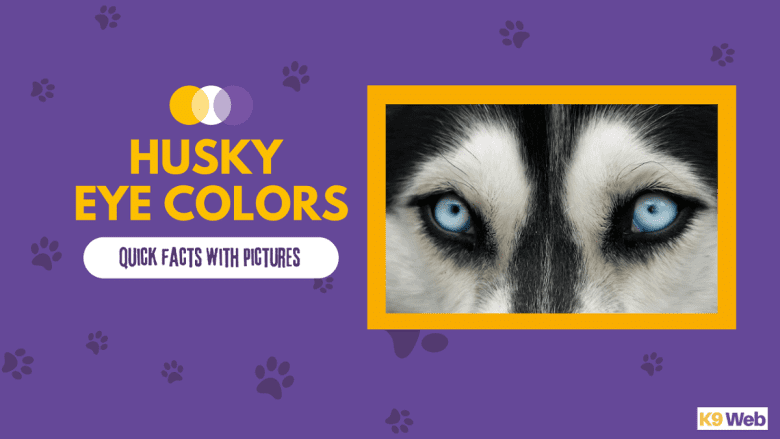
A Husky is a medium-sized dog with thick fur. These dogs originated in snowy regions, such as Siberia, where they were primarily used to pull sleds.
However, now you can find them all over the world. Huskies are very loyal and affectionate towards their owners. They can also work with determination and exhausting endurance.
These dogs are characterized by their wolf-like body shape. They have well-balanced proportions and move with ease and freedom.
Their markings also resemble the wolf, and their beautiful eyes, which can be ice blue, brown, or even bi-colored, really make them stand out from the crowd.
But just how many different colors do Husky’s eyes come in, and is it rare to find a dog with those striking blue eyes?
Also, does having blue eyes pose any problems for your pet? We will examine all this and more in the article below, so be sure to keep reading.
Quick Navigation
- 1 What Color Eyes Do Siberian Huskies Have?
- 2 Infographic about Husky Eye Colors Chart
- 3 How Do Siberian Husky Eye Color Genetics Work?
- 4 Do Husky Puppies Eyes Change Colors as They Grow?
- 5 Common Eye Problems in the Siberian Husky Breed
- 6 Frequently Asked Questions (FAQs)
- 7 Conclusion: Which Husky Eye Color Will You Choose?
- 8 Further Reading: More about Husky Dog Breed
What Color Eyes Do Siberian Huskies Have?
Huskies can come in different eye colors, like blue, brown, bi-eyed, and parti-colored and green. The first four colors are recognized by the American Kennel Club (AKC) as standard for the Husky breed.
Dogs with these color eyes are eligible to be shown at dog confirmation events.
1. Husky with Brown eyes
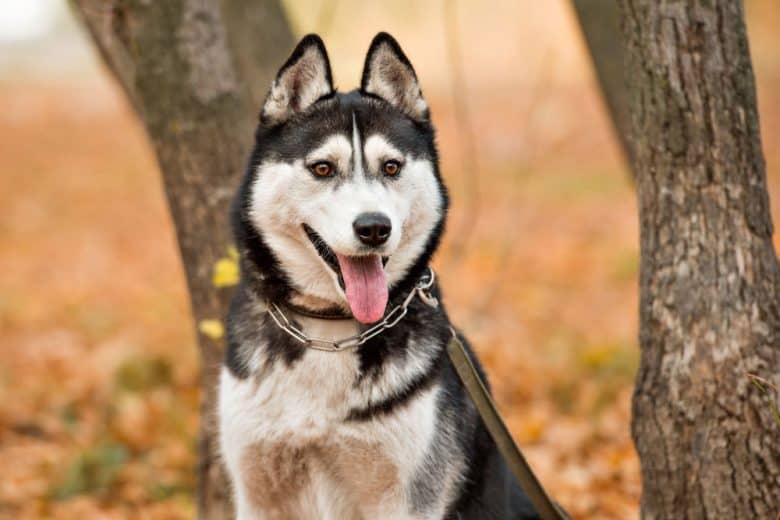
Brown is one of the standard eye colors of the Husky. Different shades of brown can be recognized, for it comes from a very light hazel tone to a rich dark chocolate brown one.
The eyes can be so dark that they almost look black. This is because the brown blends with the black pupil, giving the dog the appearance of having black eyes.
2. Husky with Blue eyes
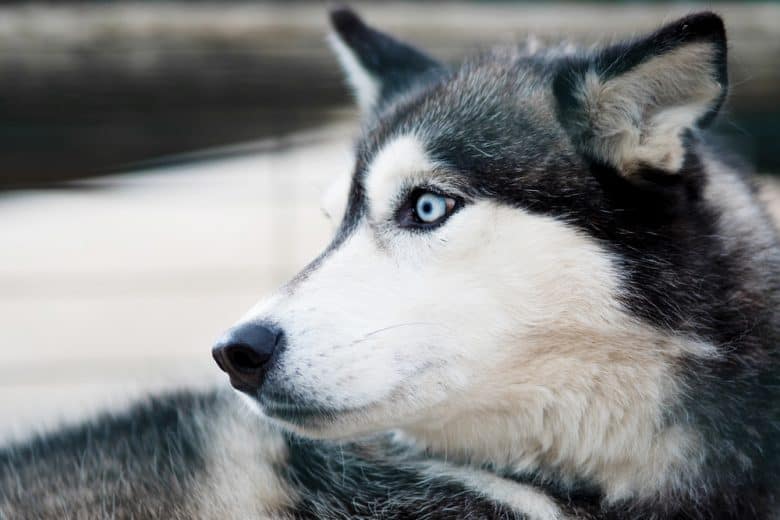
Interestingly, Husky’s eyes appear blue because of the absence of blue pigment in their eyes. A gene called ALX4, with a mutation, gives the Siberian Huskies their blue color.
Blue eyes are one of the most prominent features of Huskies.
The shades of blue can range from a light icy blue to more intense deeper blue, also blue with greens or greys in between. Some blue eyes can almost look white.
They also have a ring of black fur around their eyes, protecting them from the bright light of the sun and the reflection of light on the snow.
3. Husky with Green eyes
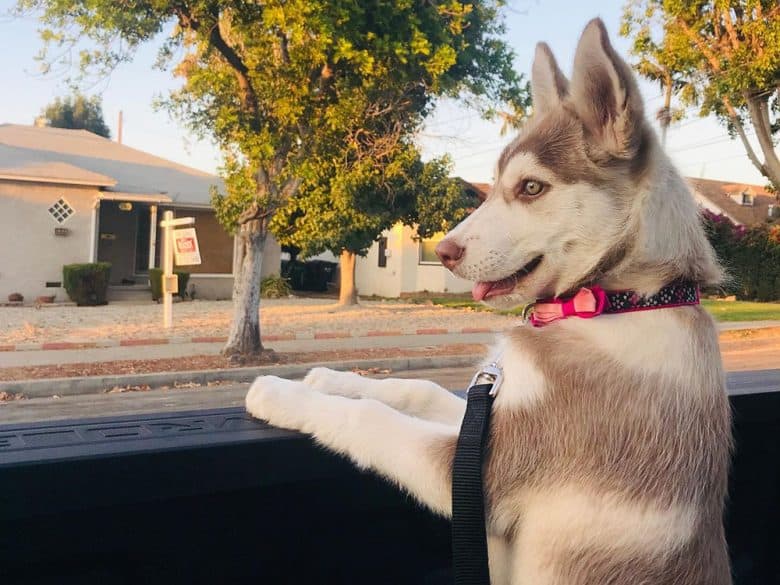
The AKC does not recognize green eyes in Huskies as standard for this breed. Green eyes are indeed very rare for this breed.
Although much research has been done on the colors of the Husky eyes, the genetics behind a green-eyed Husky is still not clear. You can sometimes see the green eye color in puppies as their milky blue eyes change into brown.
4. Bi-eyed Husky
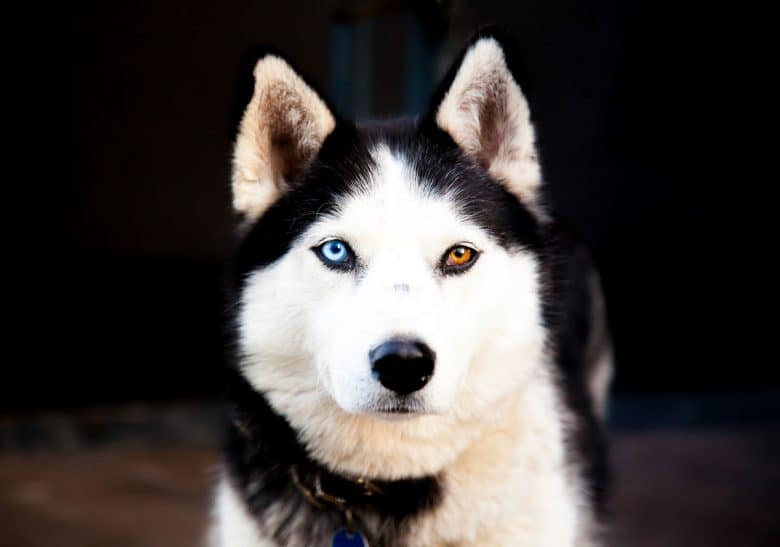
This is actually a common color combination in Alaskan Husky dogs. This is when they have their two eyes in different colors.
The most common combination for bi-eyes is blue and brown. Other combinations could be green and blue or green and brown. These are all rare because green eyes are rare.
5. Husky with Parti-colored eyes
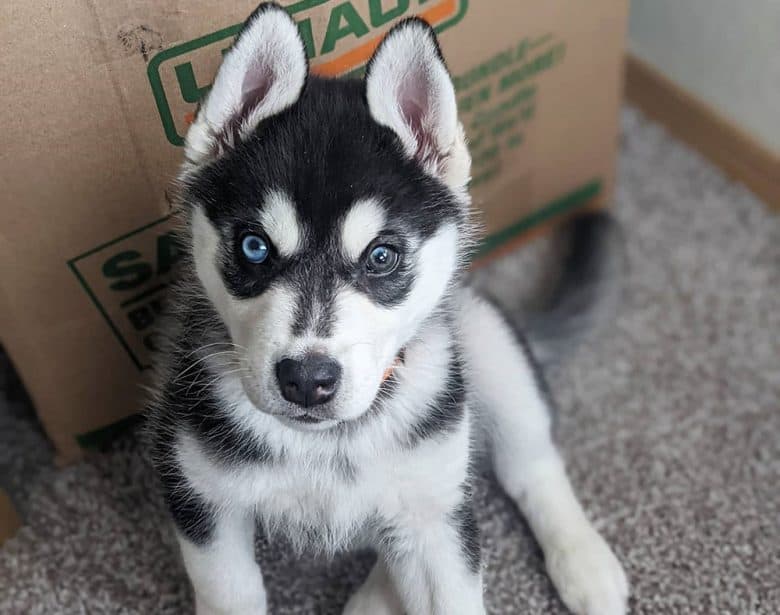
When a Husky has one eye in two different colors, he may be one out of the 5% of Huskies with a parti-colored eye.
This unusual phenomenon occurs again in combinations of blue and brown with different colored spots blended close to the eye’s outer side.
Infographic about Husky Eye Colors Chart
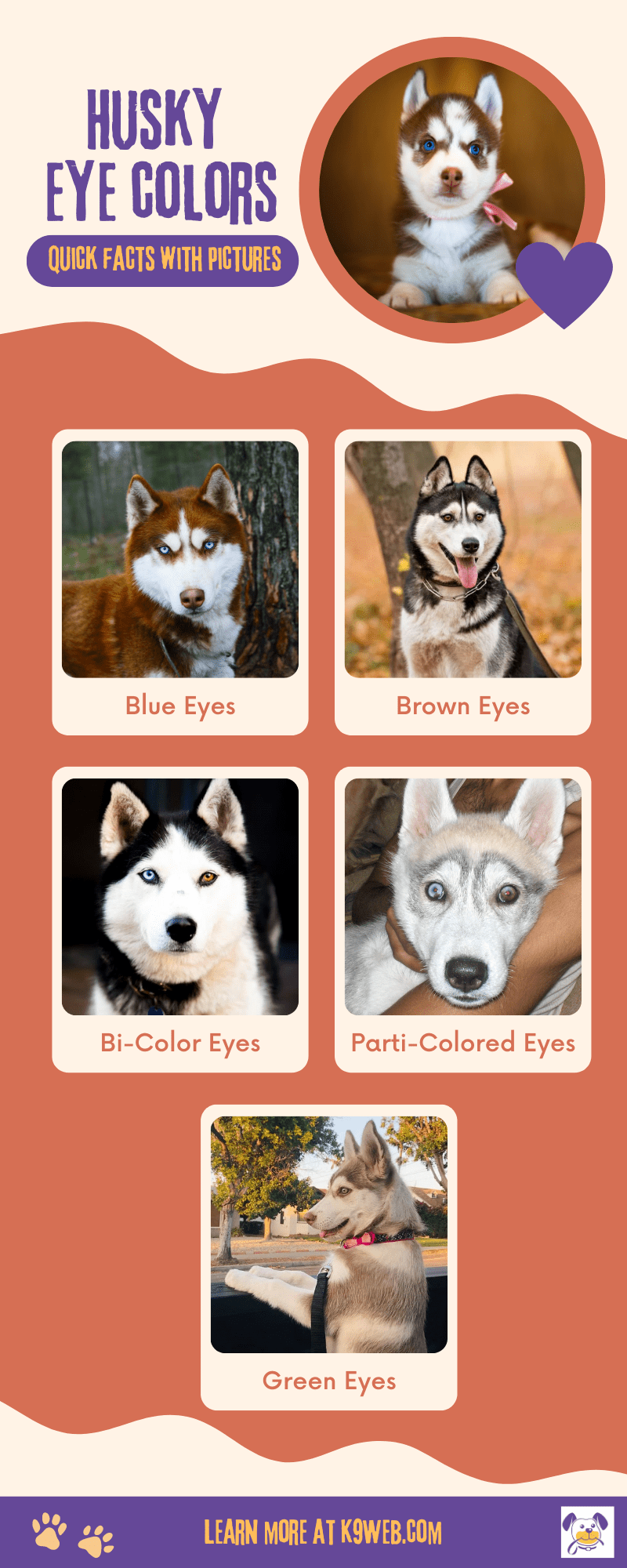
Share this Infographic on your Site:
How Do Siberian Husky Eye Color Genetics Work?
Heterochromia is a condition concerning the genetics of Husky’s eyes. This is the cause of the unique eye colors in Huskies when a dog has bi-colored or parti-colored eyes.
A dog’s eyesight is in no way influenced by Heterochromia. This genetic mutation can influence the strength of melanin and also the distribution thereof.
When there occurs a melanin deficiency, it can be responsible for iris colors being modified. Only the pigmentation is affected.
Huskies are all just as purebred, whether they possess two different colors or two blue or brown eyes.
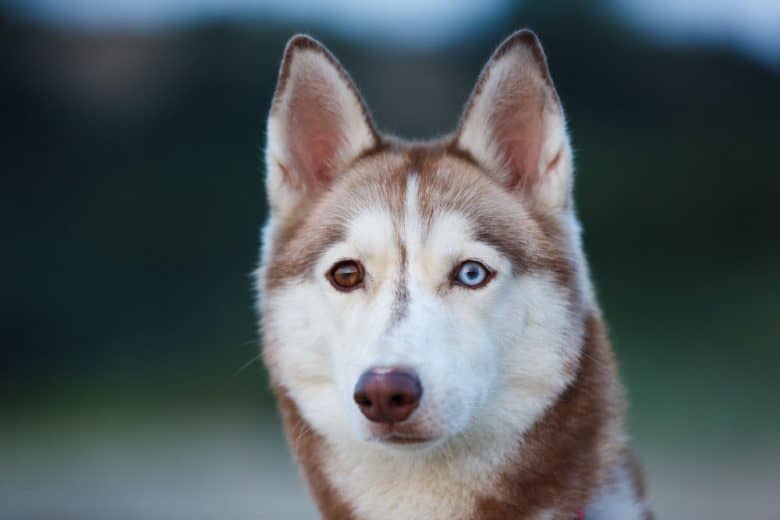
Do Huskies have different genes for their eyes compared to human eyes?
Yes, Huskies do have different genes for their eyes compared to human eyes. Heterochromia can also occur in people resulting in different colored eyes in the same person, just like the Huskies.
Although, as with dogs, humans can also inherit this phenomenon, it can also be from other causes.
Blue eyes in humans are organized by the genes HERC2 as well as OCA2. In contrast, the gene in Huskies responsible for their blue eyes is called ALX4.
Humans have 46 chromosomes, while Huskies have 78 chromosomes.
Are Huskies’ eye colors related to their coat color?
No, a Husky’s eye color is not related to his coat colors. All Huskies are born with blue eyes, although they change. Huskies can have blue eyes or brown eyes, no matter if their coats are black, brown, or grey.
Also read: The Standard & Rare Siberian Husky Coat Colors
Can purebred Huskies have different colored eyes?
Yes, bi-eyed and tri-colored eye Huskies are AKC-accredited and purebred according to the breed standard. Only Huskies with green eyes or one green eye are not accredited and thus cannot be entered into any dog shows.
It can be striking to see a Husky with different colored eyes, like one brown and one blue, or green or grey, rather than two eyes of the same color. About 15% of all Huskies are bi-eyed or have two different colored eyes.
This is a hereditary condition called heterochromia. It is caused by melanin concentration and distribution. This is still noted as typical for this breed.
Is heterochromia bad in dogs? No, heterochromia is in no way bad in dogs. Such Huskies don’t have any problems with their eyesight, and neither is it an indicator for the dog to be a mixed breed.
On the contrary, Huskies with heterochromia are recognized by the AKC as fit for the breed standard.
Are Huskies’ blue eyes actually blue?
Huskies’ blue eyes are actually not blue. The absence of pigment in their eyes makes them appear to be blue. This works the same as the sky or the ocean, looking blue from our perspective.
Why are Huskies eyes so blue? A genetic mutation near a specific gene that causes color has caused the decrease in pigment that presents in Huskies, causing them to look like they have blue eyes.
This pigmentation increase can lead to blue eyes in shades from icy blue to dark bright blue.
Do Husky Puppies Eyes Change Colors as They Grow?
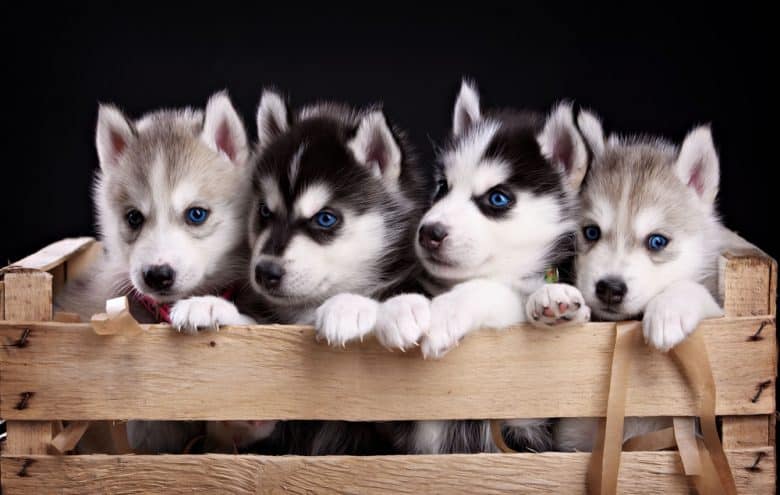
Yes, Husky’s eye color does change over time. All Husky puppies are born with blue eyes. After 8 to 10 weeks of age, some of them already have their final eye colors, although some might still go on changing even up to 6 months of age.
Their genes as well as the concentration of melanin, are responsible for the color changes.
Can Siberian Huskies experience sudden eye changes?
As your Husky puppy’s eye color is settled after about six months, there should not be an unexpected change of color after that in their lifetime.
So, if an owner becomes aware of the slightest change in the color of his Husky’s eyes, he should take it to the vet immediately.
There might just be an eye condition that needs attention, especially if the eyes look hazy blue or grey.
How can you determine a Husky’s eye color?
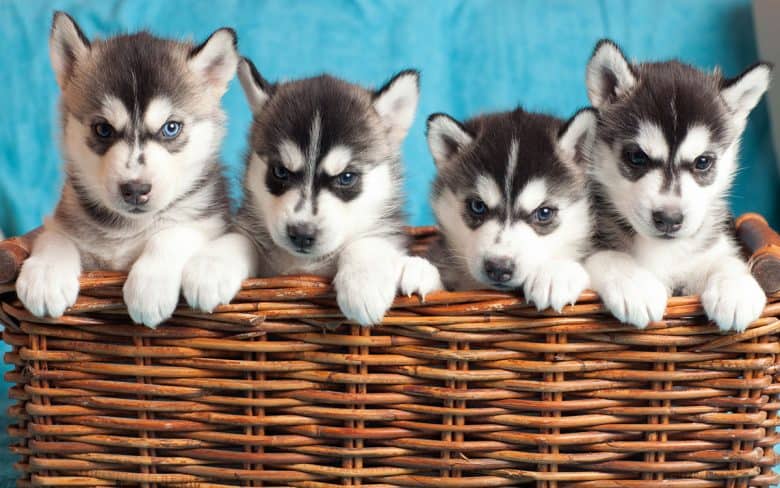
Scientists evaluation of over 6,000 pups to find that dogs’ eye colors are formulated by different genes than that of humans, mainly where blue eyes are concerned.
After birth, you will need to wait for at least 5 to 8 weeks for the transformation to happen to see what color eyes your pup will have.
Rather than using a flashlight or trying to make him look in the sunlight to check the eye color, take your dog to a vet or the breeder where you bought your pup, as they might have the experience to try and help you determine his eye color.
Common Eye Problems in the Siberian Husky Breed
Regardless of eye color, Huskies are prone to some hereditary eye defects. Veterinary ophthalmologists trained to diagnose those problems are needed to prevent the spread of these diseases.
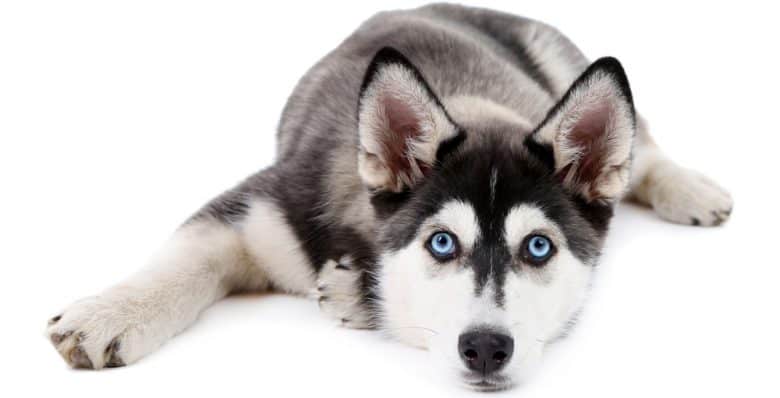
Breeding dogs should be examined during the year that the dog will be used for breeding. Breeding parents should have zero eye problems. Dogs that are related to Huskies with eye disorders should be kept away from breeding.
- Juvenile Cataracts: Huskies are one of the few breeds that suffer from juvenile cataracts which usually occur in puppies as young as three months old. This is not the same as cataracts that develop with old age.
- Corneal Dystrophy: This is an eye disease where the cornea or outer transparent part of the pup’s eyeball is attacked. Due to the fatty deposits in the cornea, the eye is turned hazy or opaque. There is not any treatment required here, although a visit to a vet ophthalmologist is a wise idea, for it may lead to corneal ulceration.
- Progressive Retinal Atrophy (PRA): It is a severe condition that can cause blindness in Huskies as early as five months old. PRA affects the dogs’ retina. Inheriting this eye disease, the pups start by losing their night vision, then their day vision, and after that, they turn blind. This afflicts with a PRA similar to that of humans, called XPRA, transmitted through a female Husky’s XX chromosomes. This is an incurable condition.
Are Huskies with blue eyes more likely to go blind? Yes, Huskies with blue eyes are prone to eye disorders, but not more than any of the other dog breeds.
So, there is not really a chance for a blue-eyed Husky to go blind, especially if the parent dogs have been tested for progressive retinal atrophy. That said, be diligent in taking your pup to the vet in due time for proper treatment.
Do they need regular vet checkups for their eyes?
Because it’s known that Huskies are prone to eye defects, it’s strongly recommended that owners should take their dogs to a capable vet on a regular basis.
In this way, any eye problems should be detected at an early stage and treated appropriately.
Frequently Asked Questions (FAQs)

What are the most common and rarest eye colors of the Husky breed?
The most common eye colors for Huskies are brown and blue. Heterochromia, which is when a dog has eyes of different colors, does appear so often in these pups that it can almost also be called common.
Green eyes are the rarest eye color and therefore bi-eyed dogs with one green eye are also seen as rare. It must also be mentioned however that this color is so rare that pups with green eyes are not actually recognized by the AKC.
Huskies with blue eyes account for 40% of all dogs of this breed while dogs with brown eyes also account for 40% of all Huskies.
Then, parti-colored eye Huskies account for 5%, and bi-eyed Huskies make up the remaining 15% of these dogs.
| Husky Eye Color | Percentage |
| Blue | 40% |
| Brown | 40% |
| Bi-eyed | 10% |
| Parti | 5% |
| Green | 5% |
Can Huskies have red eyes?
Many people are fooled by the appearance of a Husky’s eyes that might look red. This can only be a trick of the light or the red blood cells in their eyes emerging when a dog looks directly into a light source.
Taking into consideration that it’s actually impossible for their eyes to change after they settle into their permanent color shade, it might be wise to take him to the vet if a red tint in his eyes can be seen. There might be a medical need to attend to.
Are Huskies the only dogs with blue eyes?
No, Huskies are not the only dogs with blue eyes. There are other dog breeds that possess this beautiful, unusual eye color.
That said, blue eyes in other dog breeds are quite rare, with Huskies definitely having the most blue-eyed individuals.
Except for the Huskies, there are quite a few other dog breeds that can be born with blue eyes.
They include the Dachshund, Australian Shepherd, Border Collie, Weimaraner, Cardigan Welsh Corgi, Dalmatian, Shetland sheepdog, Alaskan Malamutes, and Alaskan Klee Cai.
Also read: 12 Beautiful Dog Breeds with Blue Eyes
Conclusion: Which Husky Eye Color Will You Choose?
Blue might be the most distinctive known eye color for Huskies. The blue eye color comes in a variety of blue shades ranging from almost white to dark bright blue.
Brown is another standard color for Huskies. The brown eyes also come in different shades of brown, ranging from hazel to dark chocolate brown.
The AKC recognizes both blue and brown. Both these colors are very good, but blue would be preferred by most owners because of their general rarity amongst dogs.
That said, when you get your Husky dog as a puppy, you likely won’t be able to choose the color of his eyes as all Huskies are born with blue eyes, and this color can change as your dog gets older.
What color eyes does your Husky have, and have his eyes changed color from when you first got him as a puppy? We would love to hear more about you and your pet in the comments below.
Further Reading: More about Husky Dog Breed
- Husky vs Wolf: Why Do Huskies Look Like Gray Wolves?
- Siberian Husky Price
- The 10 Best Dog Crates for Your Husky
- Siberian Husky Growth and Weight Chart
- Best Dog Food for Husky
Janine is an experienced content writer and travel journalist based in Cape, Town, South Africa.
Raised by a bundle of botanists, researchers, and biologists, she is passionate about things related to the animal kingdom, including, our furry friends. However, as a terrible allergy sufferer, she is limited in her pet selection and so has grown up surrounded by curly-haired Poodles.
